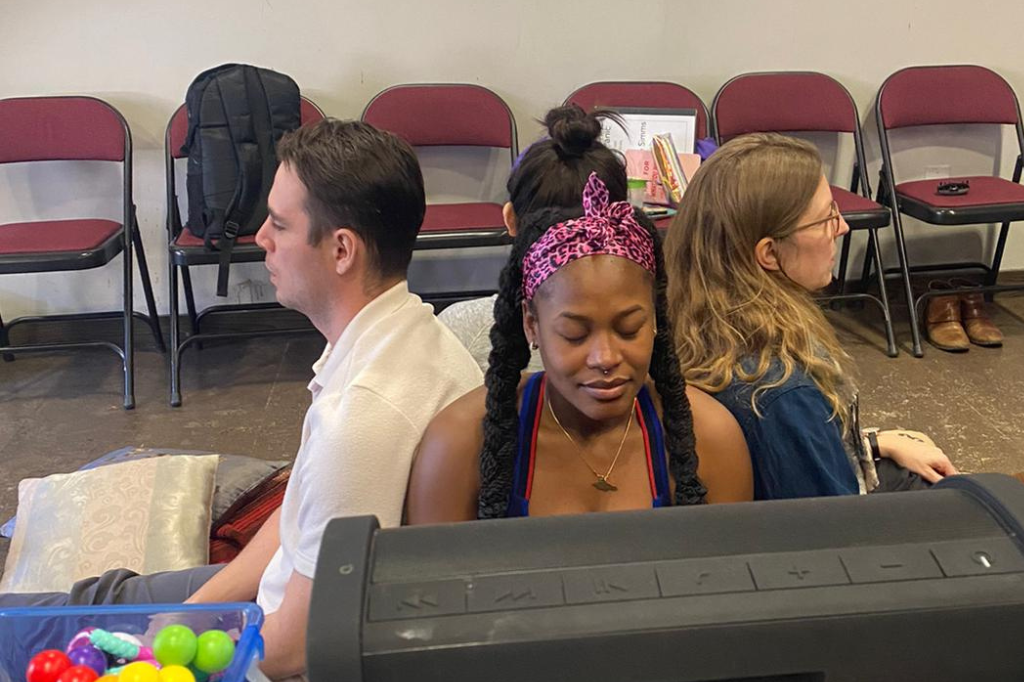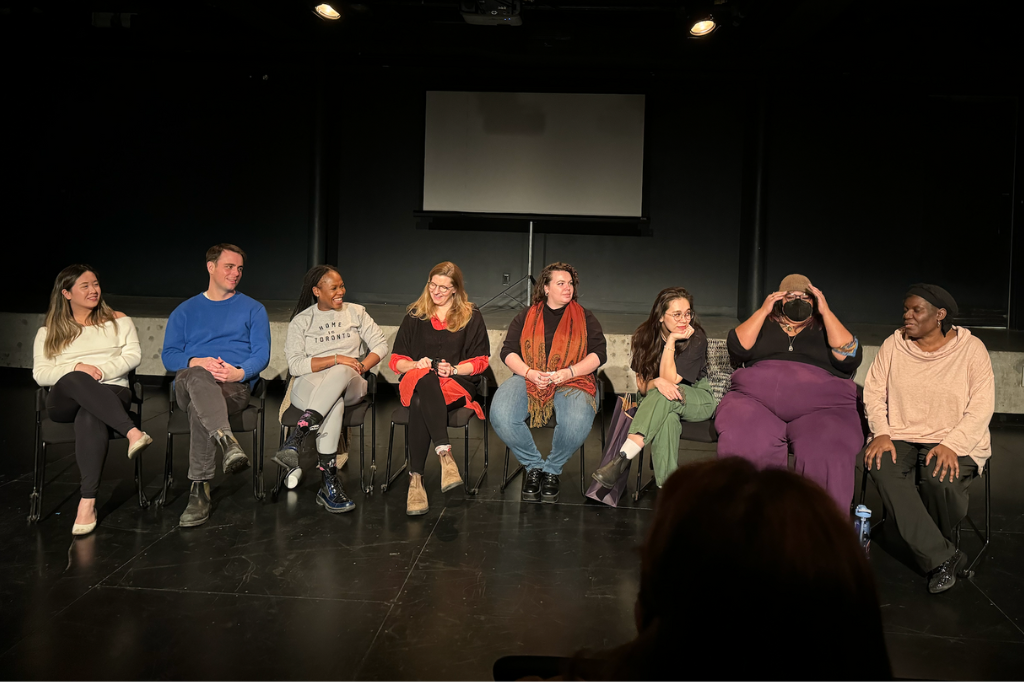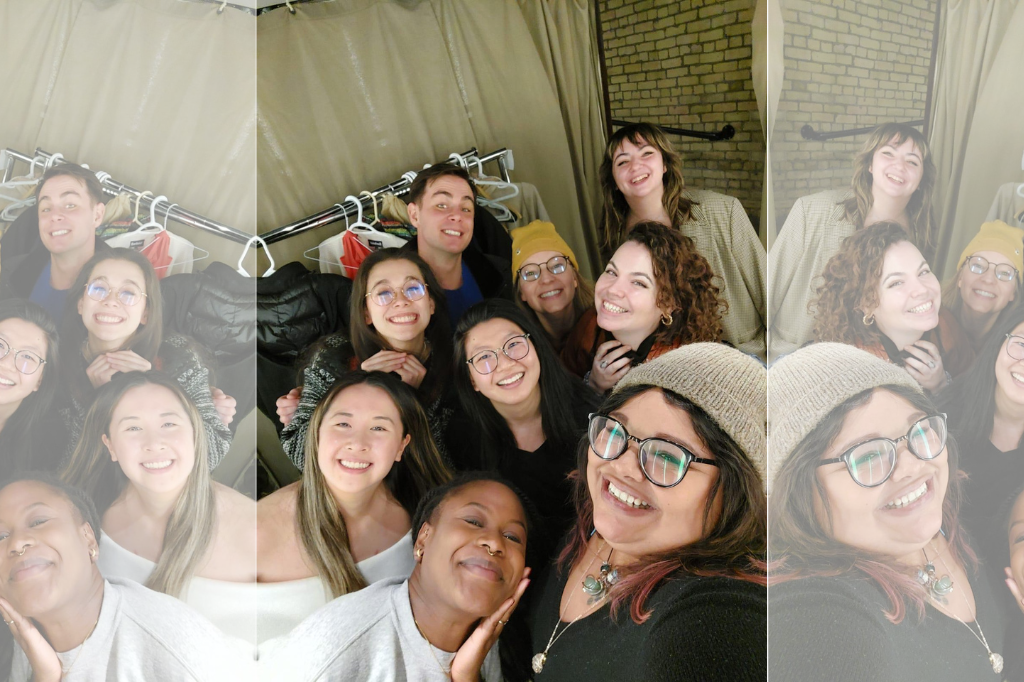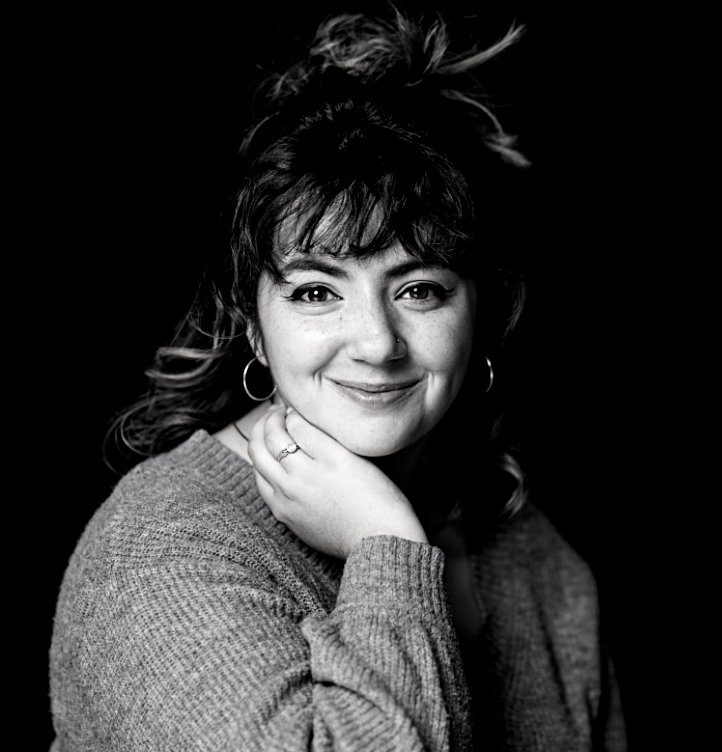The curious case of the embedded critic
What the hell is embedded criticism?
It’s a fair question, one the team behind Surge Theatre’s The Exhale asked on my first day of rehearsal. For those first few hours, I’d perched on a chair in the corner of the Cahoots Theatre rehearsal space on Queen Street East, scribbling notes, soaking in the artistic process of some of Canada’s most exciting artists: this workshop production of The Exhale, a new play by Lisa Alves, was directed by Yolanda Bonnell with dramaturgy by Tanisha Taitt and featured performances by Maev Beaty, Emerjade Simms, Kiana Woo, and Jack Copland, plus stage management by Wei Qing Tan and production assistance by Samantha Vu. Dreamy.
But why was I there?
Toronto theatre criticism is in a weird spot at the moment. Discussion around criticism in this city feels more volatile than ever before: several theatres have removed critics from their press lists, and artists continue to speak out about the harms they’ve experienced from their side of a review. For some Toronto critics, to write about local theatre is to play a no-win game of extremes, with artists on one side and critics on the other – an us-versus-them between art and its response. As a critic who went to theatre school and continues to nurture my own artistic practices, I fall somewhere in the middle.
Enter embedded criticism.
Embedded criticism places the critic inside the creative process, allowing them to bear witness to the work being done in the rehearsal room as well as the end product. As articulated by CultureBot founder Andy Horwitz, the practice seeks to level the playing field between artists and the people writing about them, offering both sides the opportunity to engage with (and learn from) one another.
An embedded critic places the journey and the destination in conversation with each other, in a way that a traditional critic can’t – even journalistic preview pieces, in which a writer chats with cast members or the creative team of a show before opening night, tend to be based solely upon interviews, rather than original observations by the writer. Embedded criticism blends the role of a critic with that of a dramaturg, meaning that the project in question gets to be documented more completely: it’s a badass solution to some of the erratic problems of traditional theatre criticism.
When Lisa reached out to inquire about an embedded critic for her new play, originally titled Queer Panic, I barely let her finish her sentence before saying I’d do it. The play, about polyamory through a sapphic lens, was rich and complicated, and the idea of embedding into its creative process felt like a golden ticket to a voyage of dramaturgical discovery. It was agreed that I’d attend three rehearsals, plus a public reading at The Theatre Centre, and write this piece for Intermission. Thanks to the Ontario Arts Council and the Ontario government’s support of early development of The Exhale, Lisa was able to pay me for this work.
A brief note on names: typically, theatre critics (and journalists more broadly) refer to artists and interview subjects by their last names. For this piece, I’ve opted to scrap that tradition and refer to the team behind The Exhale by their first names – it would be disingenuous to distance myself from the personal relationships that bloomed over the course of the play’s development period.
Let’s do this.
The embedded, or embodied, critic
The first rehearsal I attended still feels fresh in my mind.
The Exhale, as Lisa’s play was eventually re-titled (a strong choice – it much better encapsulates the emotional tilt of the piece than Queer Panic), follows Jaqueline, a university music student, and Beth, her professor. As Jaqueline (played with simmering, quiet strength by Emerjade) comes to terms with her crush on Beth (portrayed by Maev in all her ferocity and grace), the play crumples in on itself, following Jaqueline through panic attacks in real time and authentically representing the physical feeling of anxiety. We connect with the characters in three eras: during Jaqueline’s university years, at a conference five years later, and during an improbably cringey date between Jaqueline and a new boyfriend.
In its current iteration, the play is well-structured and earns its larger-than-life ending – during the public workshop that followed two weeks of rehearsal, the audience screamed and wriggled in unison, relishing in the discomfort of second-hand cringe during the final act. Delicious.
But that moment had to be found; it had to be earned.
On my first day with the team of The Exhale, Yolanda started not with the text, but with the music of the play – given Jaqueline and Beth’s shared affinity for songwriting, music serves as the backdrop for the knitting and unravelling of their relationship. After a physical warm-up (which I was invited to join, and which catapulted me back into my days of theatre school, the “one vertebrae at a time” of it all), Yolanda had the actors sit back-to-back on the floor of Cahoots, and asked them to hum in what she called a sound bath.
No prescribed notes or rhythms; no emphasis on perfection or music theory; no words. Just humming, which turned to droning, which turned to intermittent singing.
The exercise was meditative not only for the actors performing it, but for those of us at the table watching them, too. I watched Lisa close her eyes and hold a hand over her heart as the cast musicked with each other. The sound reminded me of the hum from Jordan Tannahill’s The Listeners, and immediately it was clear that this soundscape was inextricably linked with the content of the play – it had to make it into the final performance. (And it did! To open the workshop, the cast hummed together to establish the beginning of the play.)

And then the character work began – the wandering around the space in character, and the first spades into Jaqueline and Beth’s psyches, as well as that of the overbearing-but-well-meaning best friend Adriene (played with a perfect blend of spunk and tenderness by Kiana) and a revolving cast of male characters, including a fellow classmate, a hotel clerk, and Jaqueline’s new boyfriend (all played by Jack). This is the work I feel most privileged to have witnessed, from Maev’s thinking-out-loud on the inner conflicts of Beth’s latent queerness to Kiana’s wise musings on Adriene’s insecurities. In that rehearsal room, there wasn’t one wasted word – every observation, every breath, fed into the nurturing of the text, pointing towards holes in the play that Lisa could address in rewrites. From my vantage point in the corner, it was like watching a plant grow in real time, each leaf a new insight into the complex knot of Jaqueline and Beth’s feelings for one another.
In stretching with the cast, and sharing empanadas with them, and participating in Yolanda’s daily check-ins and check-outs, the “embedded” descriptor of my role seemed to melt away. I wasn’t merely watching the process, and in truth, I often forgot I was participating as a semi-journalist – being in a rehearsal room felt natural, like stepping back in time to the hazy, gentle days of theatre school.
Perhaps embedded critic is the wrong phrase. This was instead an embodied practice – physical, intimate, and forever leaving fingerprints on my future work as a critic.
”˜Do your Wordle, drink your water, and mind your business’
The Exhale is, in many ways, a play about race.
Lisa describes Jaqueline as Black in the script; Adriene is referred to as BIPOC (Kiana is Chinese-Canadian). In The Exhale, there are a few key lines about the role of race in Jaqueline’s life – seemingly throwaway lines about the new boyfriend in the third act dating a Black woman, for instance.
The second rehearsal I attended focused heavily on race in the play, opening up several hours of raw conversation about various cast members’ experiences of racially motivated aggressions, both micro and macro. On February 27, the cast and creative team of The Exhale reflected on these experiences with anger, sadness, and a tinge of hope: Tanisha memorably pointed out that “the love doesn’t make the headlines,” and that the doom of human nature is what we as a species tend to talk about and remember.
But The Exhale is also really, really funny. And despite (or even because of) these hard-hitting conversations, laughter was also a key component of the practice of creating the play. For this group of people, I imagine the mere mention of chicken cutlets will always elicit a smile. Jack’s lines about air conditioners continue to make me giggle. Maev’s guide to life – “do your Wordle, drink your water, and mind your business” – has entered my lexicon of mantras for when I’m overwhelmed.
The process is what creates the play.
That day of reflecting on race in the play hugely informed my experience of the play during the public reading. Adriene’s jokes about dating “white non-binary queers” as a woman of colour weren’t just funny – they were tinged with the lived experiences shared within the safe space of the rehearsal room. Conversations outside the context of the play left an indelible mark on the characters living inside the world of the play. I don’t know if I’d have picked up some of the subtleties of Jaqueline and Adriene’s characters without having heard the stories shared in rehearsal that informed Emerjade and Kiana’s performances.
This feels important – the process is what creates the play. Perhaps that’s obvious, but in reviewing shows several times a week, it can be easy to forget the weeks, months, and years that have gone into the one performance I’ve been able to see. My time with The Exhale was a masterclass of a reminder – and it’s my hope that this article remembers in some small way the gorgeousness of that rehearsal period, and not just the play at the end of it.
Now what?
Is The Exhale perfect, and ready for a full production without further edits? Not yet – there are further character traits to tease out (particularly for Adriene, and for Jack’s trio of men), and while the musical world of the play was gorgeously rendered for this workshop, I’m looking forward to hearing what a sound designer can create in the future.
But perfection was never the goal of this particular stage of the project. Lisa brought her team a first draft of a play, with two weeks to polish it up to something cohesive, affecting, and relatable. And she did that. The Exhale speaks to an identity I’ve not seen much of in Canadian theatre – the Stratford Festival’s 2022 production of Every Little Nookie touched on polyamory, but with The Exhale, Lisa’s been able to flesh out the experience of multiple partners in a way that never over-explains itself, with a particular focus on bisexuality that felt refreshingly true to my own experiences as a bisexual woman.
I interview theatremakers for a living, and over the years, I’ve done hundreds of interviews. Not one of them has gone over 45 minutes; even the half-hour mark is rare for me.
Until The Exhale.
My group interview with Emerjade, Yolanda, Maev, and Lisa took well over two hours, often deviating from an interview into a closed circle of not-for”“publication stories from inside the theatre industry. Perched on stools inside a dressing room at The Theatre Centre (with the equity-mandated cot at our feet), we delved into The Exhale. (Keep an eye out for future re-surfacings of this interview – in the interest of this article not being millions of words long, I’m saving most of the recording for a future piece.)
The team’s reflections on the process brought tears to my eyes.
“There’s no way that this play could be successful if you didn’t throw your whole self and your whole humanity into it,” said Emerjade, reflecting on The Exhale‘s intimate rehearsal process.
“With so many other works that I’ve been in as an actor, I haven’t trusted the space to hold myself,” added Yolanda. “It felt like they were extracting my trauma from me, which causes a reaction where I get closed-up, and tense, like, ”˜oh my god, I’m being triggered, and there’s nowhere safe to put this.’ But when you provide a space for people to be like, ”˜okay, where are you right now, what do you need?,’ when we’re dealing with traumatic things, that’s a way to make theatre in a way that’s safer.”
“None of the work on The Exhale has to happen at home,” said Emerjade. “We never have to carry this home with us. All the work happens in the space. We can leave it here and know that’s safe. We come into the space as we are, and that’s where we are. It’s just so refreshing, and a big part of the reason why this work works.”
“It feels egoless,” said Maev. “And I think that’s because of the care.”
“I remember when I first had the idea for this play,” said Lisa. “I thought, ”˜oh my god, people are going to hate this, it’s so stupid.’ I gave the script to Yolanda and Tanisha, and I was asking Tanisha, ”˜how do you receive criticism?’ Because I’ve never done that before, and I didn’t know how it would land. I was so afraid of my reaction to feedback on my play.
“And then I had a meeting with Yolanda and I got so excited,” she continued. “I was like, ”˜yes, let’s try this, let’s do it.’ It’s been my favourite part of this whole process, the dramaturgy of it all. I’ve been riding a high. This is what I came to theatre to do – to collaborate. And this process has been fully collaborative. It’s a beautiful constellation.”














Comments